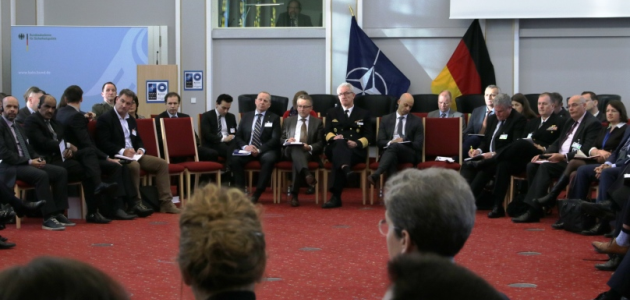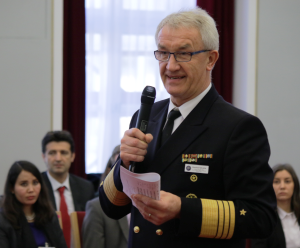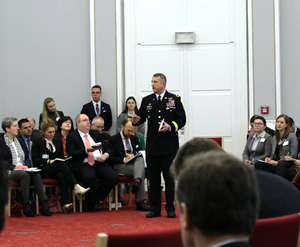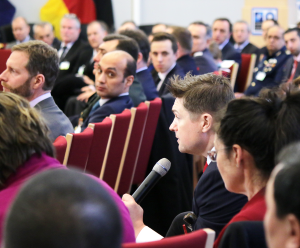NATO not only consists of 29 member nations but also maintains partnerships with 41 other states. How can these relations be adapted to the changed security environment? From 31 January to 2 February 2018, the Federal Academy hosted NATO's ACT Partnership 360 Symposium to provide both members and external partners broad space for discussion.

Deputy Supreme Alllied Commander Transformation Admiral Manfred Nielson (center), Deputy Assistant Secretary General for Political Affairs and Security Policy James Appathurai (center right), and the president of the Federal Academy Dr Karl-Heinz Kamp (center left). Picture: BAKS
„For NATO, partnerships are not an option, but a vital necessity“, a high-ranking officer sums up the backdrop of the 360 Symposium, speaking under the Chatham House Rule. Indeed NATO does not only consist of 29 member states but also maintains cooperative relations with 41 partner countries. This entails varying degrees of cooperation, ranging from political consultations about intelligence sharing and joint training up to participation in NATO missions. The Allied Command Transformation (ACT), based in Norfolk at the United States East Coast, is the Alliance’s key actor in this regard and thus the main organiser of the conference.

Admiral Manfred Nielson during his input on the future of NATO's partnerships. Picture: BAKS
NATO started its non-member partnerships immediately after the end of the Cold War and thereby, as a senior government official puts it, “did a lot for stability in Europe, especially with regard to East European countries”. However, more than 25 years later, the security environment has changed dramatically.
A new environment requires adaptation
In the 1990s “Russia was a partner, the Middle East was not good but stable, and Asia was far away”, a senior official put it in a nutshell. Today all that has changed and thus “our strategic assumptions have changed”. While critical decisions regarding the alliance’s defence posture were already made at the 2014 Wales and 2016 Warsaw Summits, the adaptations of NATO’s partnerships are the focal point of the symposium. Should the alliance approach new potential partners? Are current partnerships in need of modification? Or are there in fact co-operations that should rather be ended? Most importantly, representatives from the partner countries themselves were invited, and their strong presence at the symposium was most welcomed by all participants.

Major General William B. Hickman, ACT's Director for Strategic Plans and Policy moderated one of the discussions. Picture: BAKS
With 41 partner countries, the alliance “already has a strong basis, but there is much more potential” a senior official said.” Yet, as “NATO is always good at starting things but not so good at ending them”, the assessment ought to be critical and open for discussion, a senior military expert added. That is why the symposium takes place under the Chatham House Rule.
Discussing different threat perceptions
The debate on the future of NATO’s partnerships started with the threat assessment, a civilian official pointed out. For East European NATO members, for example, Russia’s policies pose the most imminent threat, while members form Southern Europe rather point to failed statehood and terrorist threats from the Middle East and Northern Africa. In addition, other factors like growing risks from the cyber space and North Korea’s development of nuclear weapons had to be taken into account.

The conference intentionally gave much leeway for discussion by all participants. Picture: BAKS
But values figure prominently in the debate, too, when it comes to choosing one’s partners, another senior official said. This is especially important because NATO pursues a broad vision of security, including the integration of gender perspectives and the fight against corruption in the defence sector.
Proud to be transatlantic host
The Partnership 360 Symposium literally allows a 360-degree view and provides the necessary space for these discussions. As the German government’s central educational facility for security policy, the Federal Academy regularly hosts both national and international expert conferences and meetings on security, strategy, and defence issues.
Author: Sebastian Nieke
